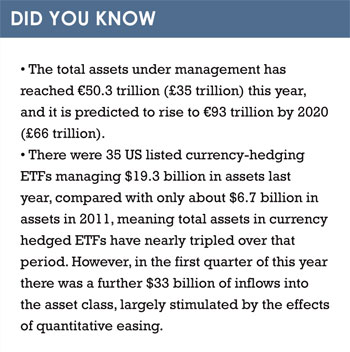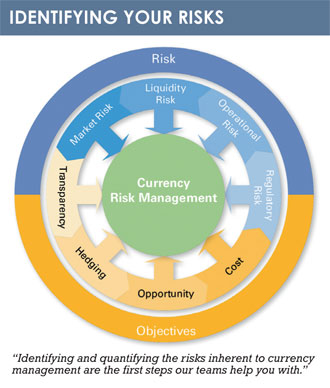As central bank policies diverge and FX volatility increases, asset managers are looking for ways to keep on top of this highly liquid market. Marc Tuehl, Global Head of FX Overlay at HSBC, explains the considerations and benefits of outsourcing currency risk management.
“In the current climate of regulatory scrutiny and increased volatility, many asset owners and asset managers are addressing their currency management processes, or indeed, lack of it.”
Investment managers expose themselves to currency risk either through international assets or demand from global investors. These risks need to be quantified and managed through a transparent, independent currency risk management process. This may consume resources, but the alternative could be costly or even crippling.
1. What factors and costs should you be aware of?
Currency has often been left unmanaged as part of a portfolio’s natural exposure. The perceived divergence in central banks’ monetary policy has seen the volatility in currency creep up again, which can have a significant impact on overall performance.
From an operational perspective, asset managers need to invest in robust systems, capable of processing exposure data from different sources and executing these efficiently. Solid controls must be in place and underlying investors are more than ever demanding transparency of the full end-to-end process.
“Clients should also consider the cost aspect. Costs such as system infrastructure, Front/Back-office, transactional, execution venue, as well as operational risk, all need to be understood and managed.”
2. When should you consider passive hedging strategies?
The strategy an asset manager implements depends on their objective. Traditionally, to attract foreign investors, managers launch ‘hedged share classes’ in locally denominated currencies. They can implement a passive hedging strategy, enabling the investor to invest in their own local currency whilst mitigating FX fluctuations relative to the fund’s base currency.
Investing in international assets can also result in foreign currency exposure. Whilst this can be part of a portfolio manager’s strategic view, reducing exposure to specific currencies can drastically improve a portfolio’s performance.
This can again be done with a passive portfolio hedge, reducing the exposure to a benchmark, say 20% or 50%. The ‘drawback’ some perceive is that by reducing exposure to a currency, one reduces not only the associated risk of it depreciating, but the potential profit if it increases in value. Other, more dynamic strategies exist.
3. So, when should you consider dynamic strategies?
These strategies adjust the hedge dynamically with the objective of achieving a predefined result. Unlike a passive strategy, which rebalances the hedge to a pre-defined benchmark (say 50% or 100%), here the hedge ratio will be a variable one, often governed by a set of rules. “Clients often engage with us, knowing that currency hedging is an important aspect of their business but looking for ways to optimise their hedging costs. Some are not even hedged because they are wary of the cashflow implications on their fully invested or illiquid assets. It is important to understand their objectives and risk metrics to identify which dynamic strategy will help them,” says Tuehl.
Often an Asset Manager will be responsible for implementing the equity or fixed income strategy, whilst FX management is outsourced to an FX Overlay provider. The provider will aim to hedge the currency exposures when the market moves against the underlying position, whilst participating when the market moves in favour. The trigger which dictates when to hedge and when to participate is strategy-specific and each produces different results in terms of volatility, return, cash-flow etc. This is why it is important to understand objectives and risk metrics prior to choosing a strategy.
4. How is the current investment climate impacting Currency Management policies?
The recent monetary stimulus has pushed up asset prices. Equities are relatively expensive while bond yields are extremely low and sometimes negative! So the low portfolio returns have left the asset managers with two options: either reduce the total volatility in the portfolio, or increase returns.
“If unmanaged, currency is often a source of uncompensated volatility. However, if managed consistently, FX can be a source of additional performance. There is a trend of clients looking to explore more alpha sources; currency markets expose investors not only to risk, but can also open doors to new opportunities. Using these opportunities could improve total returns.” comments Tuehl.
One key effect, in a market shaped by quantitative easing, is more focus on the Asset & Liability Management side of the business. In the short term, clients focus on asset liability matching investment portfolios; any mismatch on asset liability management might be taken very seriously by a governing body of investors, by regulators or clients.
Tuehl continues, “By adopting strategies to manage currency risk on a constant basis, we can change the results of the portfolio return. This is always done within a narrow corridor of the investment expectations of the client. Within the risk management we look at three main factors. The first is Risk: overall risk and the willingness of the investor to carry risk resulting from the foreign currency denomination of their assets. Second is their return expectations and third, their ability to raise cash for a hedging strategy, especially with illiquid asset classes.
5. With increased volatility, what do clients worry about?
Volatility is good for currency markets, but if the trend is against a client’s portfolio position it can have a negative impact. “Most of our clients are interested in increasing their ‘Sortino ratio’, basically returns over one-sided volatility, and to achieve this, they might consider Dynamic strategies. HSBC’s Systematic Overlay Management strategy, for example, aims to hedge negative moves and participate in positive ones.” Certain clients just look for passive currency services, seeking transactional efficiency and transparency of execution.
Currency management should raise four questions for clients:
1. The exposure and management element i.e. do I (need to) know what my currency exposure is on a particular date?
2. What kind of strategy do I apply to my exposure?
3. How do I execute?
4. How do I fulfil the governance and regulatory duties?
 “Sometimes currency performance is not deemed important by an asset manager, instead it is simply associated with a specific underlying investment. We observe investors demanding more transparency around what exactly they’re invested in; they want to know what component of the return results from a specific investment, and what part of their overall performance results from FX. Also, if the FX is hedged, what is the impact of the interest rate differential?” says Tuehl.
“Sometimes currency performance is not deemed important by an asset manager, instead it is simply associated with a specific underlying investment. We observe investors demanding more transparency around what exactly they’re invested in; they want to know what component of the return results from a specific investment, and what part of their overall performance results from FX. Also, if the FX is hedged, what is the impact of the interest rate differential?” says Tuehl.
Investors want to understand what the risks are and where the performance is coming from.
6. What should we expect in the FX market going forward?
The internationalisation of the Renminbi has increased its value drastically. “We’re already seeing high liquidity,” says Tuehl. “Market movements in the last year have led to questions from both onshore and offshore clients on how to manage a currency pair. For a long time the Renminbi development was one-sided. Now we’re seeing two-way volatility, which increased the risk, but also opens the door for additional returns.”
Asset managers are also being urged to offer more currency-hedged share classes or even currency-hedged ETFs. Such a process can be very complex and outsourcing is designed to help mitigate this risk and reduce front/back office space and overall cost.
©2015 funds europe





